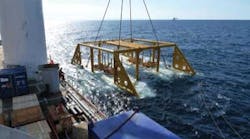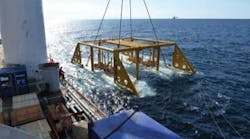Norway cautious on extending exploration
Jeremy Beckman • London
Norway is offering 62 blocks or part-blocks under its Awards in Predefined Areas 2011 licensing round. Fifty-six of the blocks are in mature parts of the Norwegian Sea, with the remainder in the North Sea. Bids are due by Sept. 14, with awards set to follow around the turn of the year.
Petroleum and Energy Minister Ola Borten Moe said the government’s long-term goal was to maintain a stable level of activity throughout the Norwegian continental shelf. This would involve opening further areas to exploration, including far-north regions near Jan Mayen and currently unlicensed acreage in the southern Barents Sea.
However, the government has decided to delay its assessment of the impact of future E&P on the Lofoten and Vesteraalen regions off northern Norway. Despite intensive industry lobbying, these areas have remained off-limits due to pressure from local fishing and environmental groups.
Statoil was not pleased with the decision – the company claims that without access to new acreage, Norway faces a steep decline in production post-2020. On the other hand, CEO Helge Lund welcomed the government’s promise to re-open the assessment process at a later date, after it has commissioned new data.
UK operators hit by tax rise
Britain’s government has sprung a surprise tax hike on UK offshore producers. It has raised the supplementary charge rate from 20-32%, lifting the marginal tax rate on mature North Sea fields from 75% to 81%, and the rate for non-PRT fields from 50% to 60%. The government also announced plans to restrict relief for decommissioning costs. However, the changes could be rescinded if the oil price falls back to $75.
The revenue-raising measures drew widespread rage and disbelief from the industry. Malcolm Webb, CEO of Oil & Gas UK, said the change would damage investor confidence in the sector. KPMG oil and gas transactions partner Anthony Lobo foresaw an impact on M&A activity, with the new rates lowering the value of some North Sea assets that the majors are trying to sell.
EnCore Oil is one of the sector’s leading play-openers, with a string of recent exploration successes in the central North Sea. CEO Alan Booth said: “Failure to encourage the discovery of new fields as well as the development of newer, smaller, and difficult fields on fair and predictable fiscal terms is in no one’s interest.”
Others, such as Premier Oil, appeared more philosophical, pointing out that the changes could be offset by the UK’s recently introduced Field Allowances.
Ithaca Energy, one of the supposedly threatened marginal field specialists, said it would persevere with its new UK development projects. And Valiant Petroleum, after warning that it might reconsider committing to new projects, announced plans to co-fund a well on the Orchid prospect in the central North Sea.
Ostensibly, however, the government has taken note. The Energy and Climate Change Select Committee was due to hold an evidence-gathering session on May 4 to review the impact of the tax regime changes. Oil & Gas UK planned to publish its own findings by the end of April.
OSPRAG to implement well cap system
Cameron is manufacturing a well capping device at its plant in northern England that will feature in the UK’s oil spill response contingency plans. The device was commissioned by the Oil Spill Prevention and Response Advisory Group (OSPRAG) in response to the Macondo well blow-out, with OSPRAG also overseeing design development with BP and JP Kenny.
The cap will be deployable from a multi-service vessel in a wide range of oil spill scenarios offshore the UK, including the most hostile conditions west of Shetland, and can be attached to various parts of the leaking equipment to seal off or cap the oil flow.
Culzean well flows hard for Maersk
Maersk claims to have a “significant” hydrocarbon accumulation in the HP/HT Culzean prospect in the UK central North Sea. An appraisal well was drilled to verify an extension of the 2008 discovery (22/25a-9z) – it encountered gas and condensate in Triassic and Jurassic reservoirs, testing at a constrained rate of 40 MMcf/d of and 900 b/d of condensate from two intervals. Maersk and its partners planned to drill a sidetrack down flank to the east of the latest well to assess the field’s full extent.
Det norske states case for Draupne
Det norske oljeselskap has applied for an environmental impact assessment for its Draupne field in the Norwegian North Sea.
Draupne schematic.
Draupne is one of the sector’s major undeveloped finds – it was discovered in 2008 and appraised last year, with tests suggesting that production wells could each deliver around 12,000 b/d of oil.
The field could be co-developed with Hanz and West Cable, two smaller accumulations in the same southern Viking Graben formation.
However, Det norske has ruled out submitting a re-development plan this year for the Frøy field in the same sector, thought to hold 60 MMbbl of recoverable oil.
The company had hoped to file its preferred concept this fall, based around an FPSO, with simultaneous water and gas injection (SWAG) to aid production rather than water injection only. But evaluation studies indicated that SWAG would have only a marginal impact on the project’s economics.
Offshore Articles Archives
View Oil and Gas Articles on PennEnergy.com

